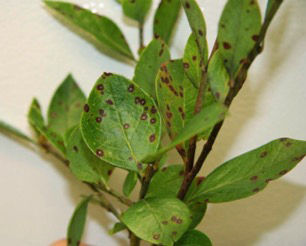By Clint Thompson
It is never too early to start thinking about next year if you are a blueberry producer. In fact, growers need to manage for leaf spot diseases if they expect to make a crop the following season.

Credit: P. Harmon, UF/IFAS
Jonathan Oliver, University of Georgia (UGA) assistant professor and small fruits pathologist, discussed the situation during the Alabama Fruit and Vegetable Growers Association (AFVGA) annual meeting in early February.

“Mostly when we think about leaf spots, most of that time period when the plant is growing is after when you’ve already harvested fruit for this year. If you think about it, why would I bother to put out an expensive fungicide at this point to manage a leaf spot when I’ve already got my crop for this year?” Oliver said.
“Blueberries set their fruit buds for next year during this season. If you’re not controlling those leaf spots, then the plant is not capturing as much of the sun’s energy and putting it into new buds and storing it up for the winter like it should. Next season it will impact yield. We’re trying to get that across that you do need to maintain your foliage on blueberries if you’re in commercial production. It will impact yield next season if you don’t.”
Leaf spots reduce photosynthesis, leading to less energy production and storage for a healthy plant. Chemical controls are recommended for management of leaf spot diseases. For septoria, between 2 and 4 fungicides are required. Phosphonates, including Aliette and ProPhyt, are best utilized after harvest, since they are not as efficacious against fruit rots and serve as a resistance management tool.
For anthracnose, fungicides that control ripe rot are effective with phosphonates utilized after harvest.
For leaf rust, Strobilurins and DMIs used for other leaf spots, also have activity against rust.









